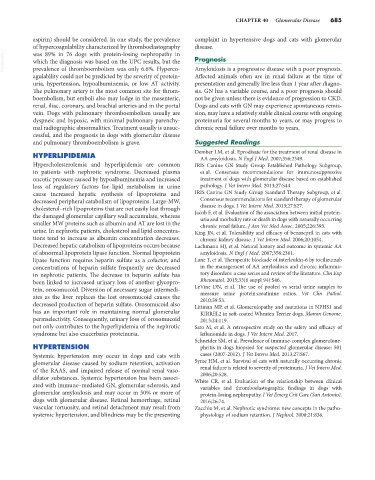Page 713 - Small Animal Internal Medicine, 6th Edition
P. 713
CHAPTER 40 Glomerular Disease 685
aspirin) should be considered. In one study, the prevalence complaint in hypertensive dogs and cats with glomerular
of hypercoagulability characterized by thromboelastography disease.
VetBooks.ir was 89% in 76 dogs with protein-losing nephropathy in Prognosis
which the diagnosis was based on the UPC results, but the
prevalence of thromboembolism was only 6.6%. Hyperco-
Affected animals often are in renal failure at the time of
agulability could not be predicted by the severity of protein- Amyloidosis is a progressive disease with a poor prognosis.
uria, hypertension, hypoalbuminemia, or low AT activity. presentation and generally live less than 1 year after diagno-
The pulmonary artery is the most common site for throm- sis. GN has a variable course, and a poor prognosis should
boembolism, but emboli also may lodge in the mesenteric, not be given unless there is evidence of progression to CKD.
renal, iliac, coronary, and brachial arteries and in the portal Dogs and cats with GN may experience spontaneous remis-
vein. Dogs with pulmonary thromboembolism usually are sion, may have a relatively stable clinical course with ongoing
dyspneic and hypoxic, with minimal pulmonary parenchy- proteinuria for several months to years, or may progress to
mal radiographic abnormalities. Treatment usually is unsuc- chronic renal failure over months to years.
cessful, and the prognosis in dogs with glomerular disease
and pulmonary thromboembolism is grave. Suggested Readings
Dember LM, et al. Eprodisate for the treatment of renal disease in
HYPERLIPIDEMIA AA amyloidosis. N Engl J Med. 2007;356:2349.
Hypercholesterolemia and hyperlipidemia are common IRIS Canine GN Study Group Established Pathology Subgroup,
in patients with nephrotic syndrome. Decreased plasma et al. Consensus recommendations for immunosuppressive
oncotic pressure caused by hypoalbuminemia and increased treatment of dogs with glomerular disease based on established
loss of regulatory factors for lipid metabolism in urine pathology. J Vet Intern Med. 2013;27:S44.
cause increased hepatic synthesis of lipoproteins and IRIS Canine GN Study Group Standard Therapy Subgroup, et al.
decreased peripheral catabolism of lipoproteins. Large-MW, Consensus recommendations for standard therapy of glomerular
disease in dogs. J Vet Intern Med. 2013;27:S27.
cholesterol–rich lipoproteins that are not easily lost through Jacob F, et al. Evaluation of the association between initial protein-
the damaged glomerular capillary wall accumulate, whereas uria and morbidity rate or death in dogs with naturally occurring
smaller MW proteins such as albumin and AT are lost in the chronic renal failure. J Am Vet Med Assoc. 2005;226:393.
urine. In nephrotic patients, cholesterol and lipid concentra- King JN, et al. Tolerability and efficacy of benazepril in cats with
tions tend to increase as albumin concentration decreases. chronic kidney disease. J Vet Intern Med. 2006;20:1054.
Decreased hepatic catabolism of lipoproteins occurs because Lachmann HJ, et al. Natural history and outcome in systemic AA
of abnormal lipoprotein lipase function. Normal lipoprotein amyloidosis. N Engl J Med. 2007;356:2361.
lipase function requires heparin sulfate as a cofactor, and Lane T, et al. Therapeutic blockade of interleukin-6 by tocilizumab
concentrations of heparin sulfate frequently are decreased in the management of AA amyloidosis and chronic inflamma-
in nephrotic patients. The decrease in heparin sulfate has tory disorders: a case series and review of the literature. Clin Exp
been linked to increased urinary loss of another glycopro- Rheumatol. 2015;33(6 suppl 94):S46.
tein, orosomucoid. Diversion of necessary sugar intermedi- LeVine DN, et al. The use of pooled vs serial urine samples to
measure urine protein:creatinine ratios. Vet Clin Pathol.
ates as the liver replaces the lost orosomucoid causes the 2010;39:53.
decreased production of heparin sulfate. Orosomucoid also Littman MP, et al. Glomerulopathy and mutations in NPHS1 and
has an important role in maintaining normal glomerular KIRREL2 in soft-coated Wheaten Terrier dogs. Mamm Genome.
permselectivity. Consequently, urinary loss of orosomucoid 2013;24:119.
not only contributes to the hyperlipidemia of the nephrotic Sato M, et al. A retrospective study on the safety and efficacy of
syndrome but also exacerbates proteinuria. leflunomide in dogs. J Vet Intern Med. 2017.
Schneider SM, et al. Prevalence of immune-complex glomerulone-
HYPERTENSION phritis in dogs biopsied for suspected glomerular disease: 501
Systemic hypertension may occur in dogs and cats with cases (2007-2012). J Vet Intern Med. 2013;27:S67.
glomerular disease caused by sodium retention, activation Syme HM, et al. Survival of cats with naturally occurring chronic
of the RAAS, and impaired release of normal renal vaso- renal failure is related to severity of proteinuria. J Vet Intern Med.
2006;20:528.
dilator substances. Systemic hypertension has been associ- White CR, et al. Evaluation of the relationship between clinical
ated with immune–mediated GN, glomerular sclerosis, and variables and thromboelastographic findings in dogs with
glomerular amyloidosis and may occur in 50% or more of protein-losing nephropathy. J Vet Emerg Crit Care (San Antonio).
dogs with glomerular disease. Retinal hemorrhage, retinal 2016;26:74.
vascular tortuosity, and retinal detachment may result from Zacchia M, et al. Nephrotic syndrome: new concepts in the patho-
systemic hypertension, and blindness may be the presenting physiology of sodium retention. J Nephrol. 2008;21:836.

